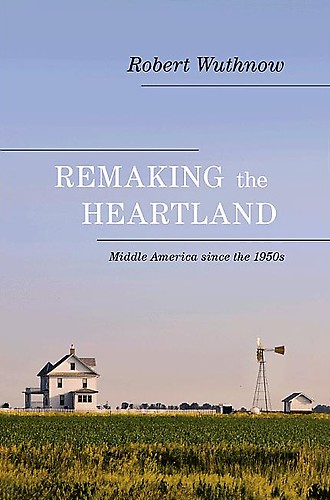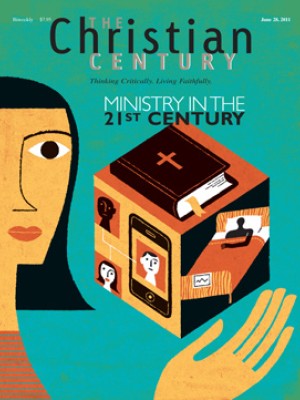Remaking the Heartland, by Robert Wuthnow
In most ways Robert Wuthnow gets it right. This social history of the Middle West demonstrates how the values that emerged in the six decades before 1950 were reshaped in the following six decades. He reports that the Middle West was remade out of many of the same values that contributed to the region's resilience and ingenuity.
A values analysis of the culture of this nine-state region (Arkansas, Iowa, Kansas, Minnesota, Missouri, North Dakota, Nebraska, Oklahoma and South Dakota) over the past 60 years reveals that the conflict pervading the period has been between aggressive expansion and growth on the one hand and a desire for a traditional, relational and slower pace of life on the other. Similarly, the business of accommodating newcomers and pursuing new businesses and all those features that growth requires stands poised against the lifestyle of having good friends, quiet neighborhoods, conservative values and a connection to nature.
Read our latest issue or browse back issues.
What is striking in Wuthnow's analysis is how many Middle West values have enabled small towns to accommodate growth. To be sure, those values have done some shape shifting, but one can still recognize the skeletal outlines of them in this analysis. For example, the value that immigrants to the region put on education and postsecondary schools, including the colleges and universities they established, are still reflected in educational rankings; this feature has made for an educated and resilient population.
Four times Wuthnow highlights the ingenuity of Middle West culture. The preservation of neighborliness and the continuing quest for community have become almost stereotypical of the region. To be sure, there are real differences over time: the extractive industries of the era of family farming have mostly given way to avionics, biotechnology, oil, the military and casinos. What has emerged are edge cities that manage to maintain green space and trails in the midst of corporate villages and concentrated business centers.
We are fortunate to have a social scientist and historian with the stature of Robert Wuthnow undertake the sort of study that draws on oral history interviews, newspaper accounts, census data and broad cultural histories and interpretations. Wuthnow adds a new perspective on rural life and culture, the story of which too often ends with economic decline and hence a social decline, as happened to farmers in the 1980s. He moves past the elegies of "broken heartlands" and recognizes the rebirth of Middle America. In many ways, Kansas ain't Kansas anymore. His being native to this place helps him to uncover the vast unknown of the Middle West, which henceforth need no longer be unknown.
Remaking the Heartland makes good on its central claim that "the American Middle West has undergone a strong, positive transformation since the 1950s." The author says that he "opted for what we sociologists call a multimethod research design," which would "combine statistical data about individuals, towns, and counties with qualitative information about local histories, events, and perceptions drawn from interviews, observations, and publications." This method will please both ethnographers and narrative participant-observers. What saves the book from statistical overload is the way interviews with particular people demonstrate the impact of the data; especially good are the interviews in which interviewees describe the change they have seen over their lifetime, usually four or five decades. Equally helpful are the "core samples" that the book uses from places like Smith County, Kansas; Vinton, Iowa; Mayville, North Dakota; and Garden City and Olathe, Kansas. The book reminds me of the joining of narrative style and substance that makes Cynthia M. Duncan's Worlds Apart: Why Poverty Persists in Rural America such fascinating reading.
The chapter that concentrates on the careful growth and harmonious integration of ethnic groups in Garden City, Kansas, inspires the reader to think that many agriculturally dependent towns can become interesting and economically vibrant communities. (Saint Paul School of Theology, where I teach, has a rural, multicultural immersion in Garden City and Dodge City, Kansas, every fall.) The edge city phenomenon, which Wuthnow documents in Olathe, Kansas, involves many separate towns growing together into a metropolitan center, in this case Kansas City. Edge cities have a small-town feel, with green spaces, hiking and biking trails, churches, and neighborhood and other voluntary associations. At the same time residents of edge cities like Olathe can easily enjoy all the benefits of city living: theater, ballet, shopping, restaurants, concerts, sports, movies and so on. This is an example of the way the Middle West can maintain its identity while the forces of globalization threaten to homogenize the U.S.
However much I applaud Wuthnow's appreciation for Middle West values and the perseverance of many towns, I have two bones to pick with him. The first is simply that he uses statistical averages in a way that can disguise the ongoing pain of many rural, formerly agriculturally based communities. Many other books have left the impression that all farming and rural communities are destitute, either because of their own laziness or incompetence or because competent people are leaving. In correcting this egregiously negative image, Wuthnow leans in the opposite direction. But there is much evidence of the injustice perpetrated by our national cheap-food policies; farmers and rural communities have paid a price so the rest of us can eat cheaply and well.
My second concern is more significant. Wuthnow barely mentions the churches of the Middle West. Talcott Parsons, the sociologist of functionalist fame, at least recognized that religion is one of society's major institutions. That is especially true in the Middle West. Much of the ingenuity, leadership, community-mindedness, emphasis on education and appreciation for nature that Wuthnow so rightly applauds is due to the influence of the churches. Nowhere does Wuthnow pay the church its due, even in an empirical, hard-headed sociological way.
For the churches in the nine states (and they are legion), however, this book demonstrates some of the directions they can take to maintain their values that are worth conserving at the same time as they find ways to strengthen the cultural and economic bases of their communities.







